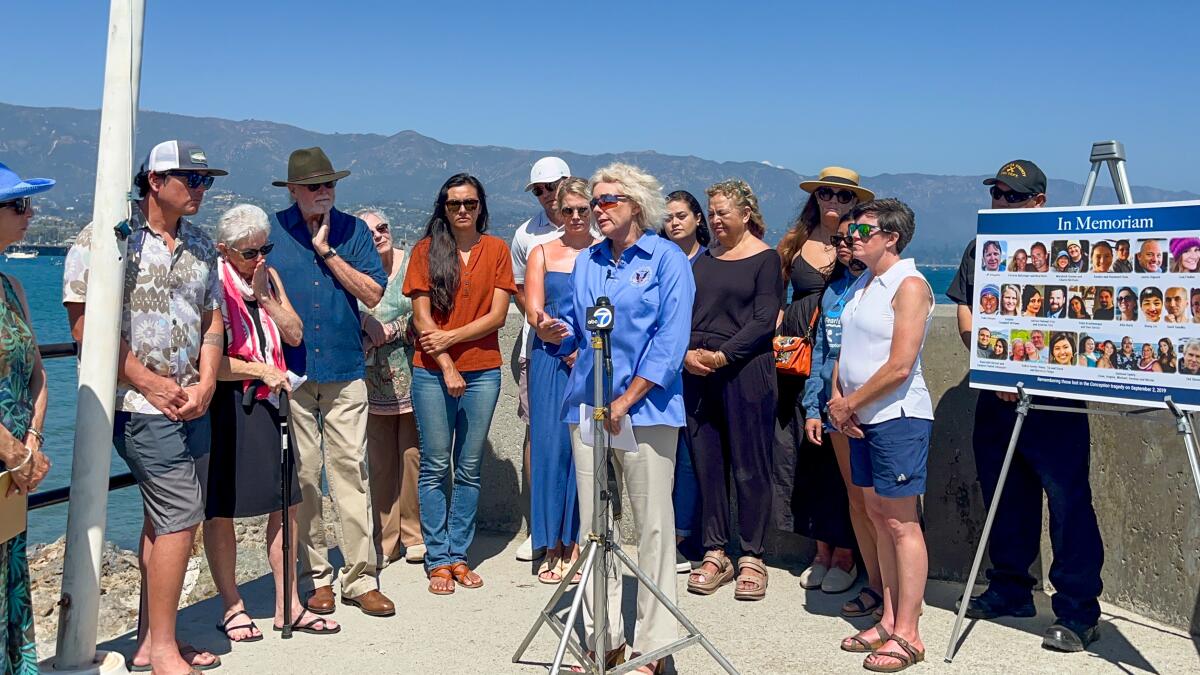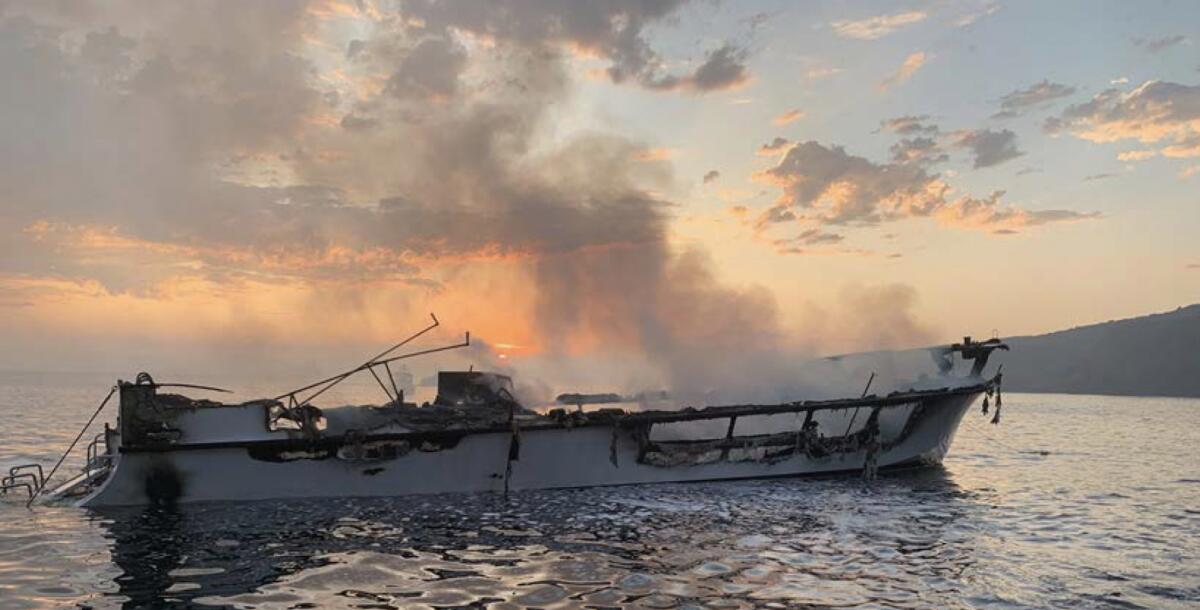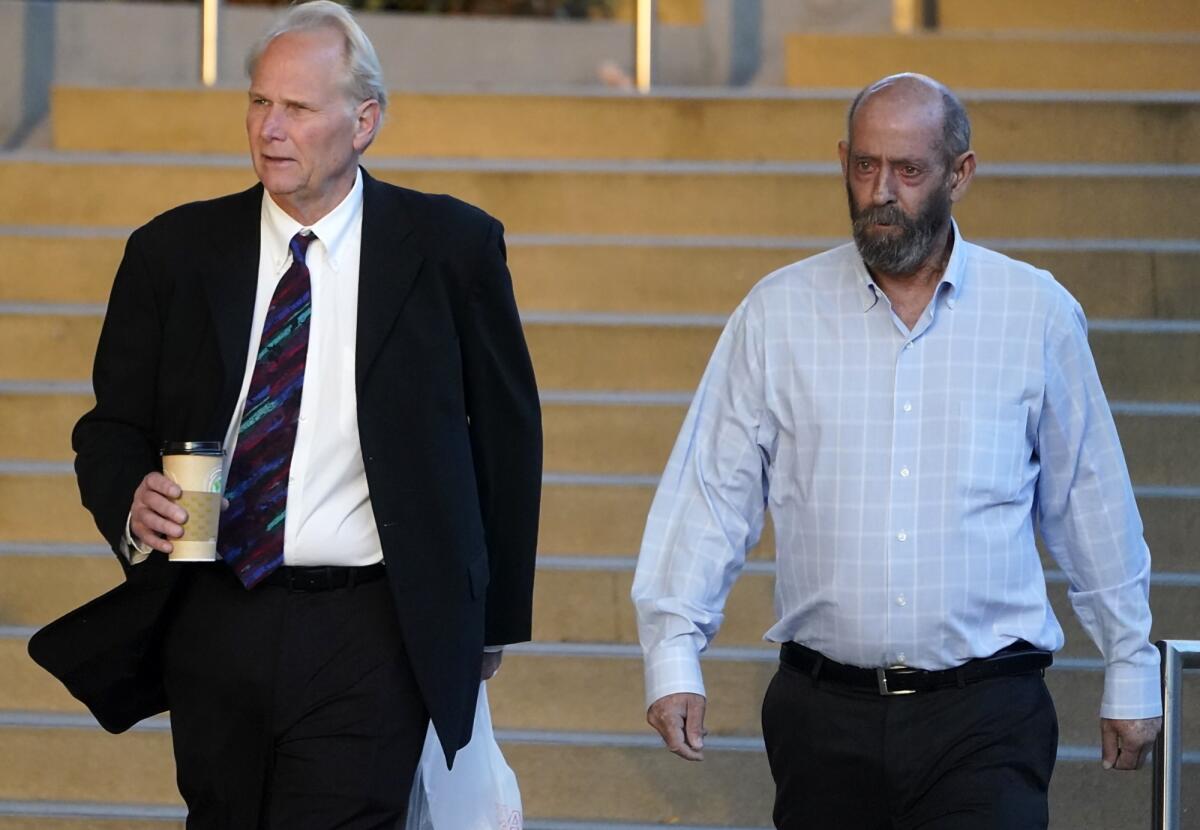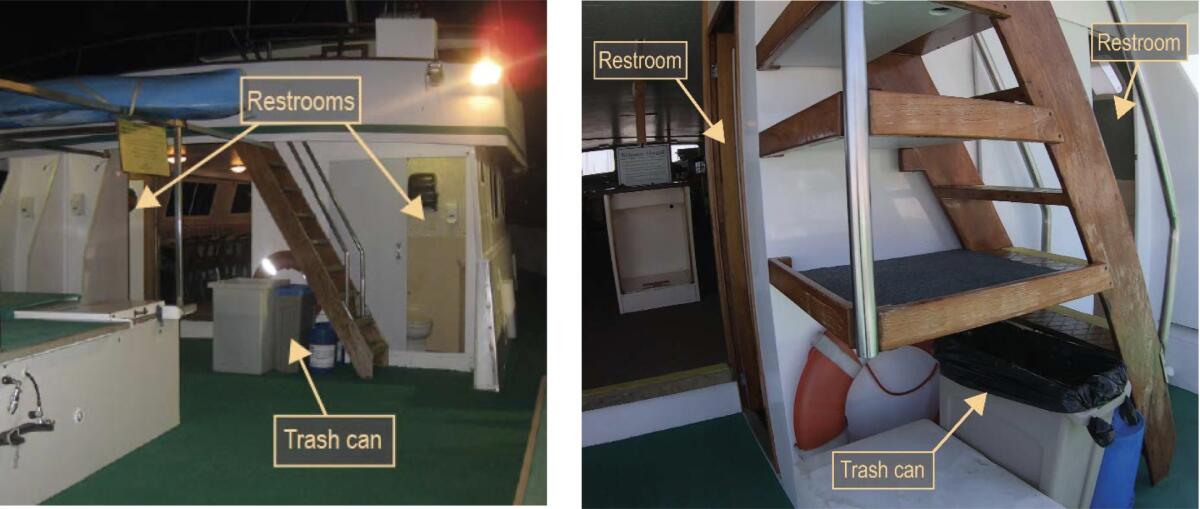
Five years after California’s worst modern maritime disaster, relatives of victims of the Conception fire are angry at what they call the slow pace of accountability, while a top U.S. safety official says the Coast Guard continues to delay reforms.
Thirty-four people died aboard the Conception on Labor Day 2019, when a fire broke out on the main deck while dozens of divers slept in a windowless cabin below. In the smoke and chaos, they desperately tried to find a way to safety on the 75-foot dive boat but were unable to escape.
Jennifer Homendy, chairwoman of the National Transportation Safety Board, lambasted the Coast Guard at a news conference Monday for failing to require safety management systems for small vessels.
“How many deaths must occur? How many injuries must occur? How many families must stand here at a press conference to mourn their loved ones before action is taken?” Homendy asked as she stood near a plaque at the Santa Barbara Harbor commemorating the victims of the Conception. “And how many times does Congress, which did it again in 2021, have to come together to demand an explanation?” [have to] “Tell the Coast Guard to take action?”

Jennifer Homendy, chairman of the National Transportation Safety Board, speaks Monday at the Port of Santa Barbara among family members of those who died on the dive boat Conception five years ago.
(Richard Winton / Los Angeles Times)
Homendy, joined by victims’ relatives, said her agency has made recommendations for safety management systems going back more than two decades, the most recent being the one for the Conception fire.
She sent a letter Monday to the secretary of Homeland Security and the head of the Coast Guard, asking them to implement the change “with all possible dispatch.”
In a July letter to the NTSB, Coast Guard Vice Adm. Peter Gautier said he had “worked diligently” on a notice of proposed rulemaking with “all due diligence” on safety management systems. But Homendy said that explanation was unacceptable “given the long history of inaction.”
Homendy said a safety management system establishes common-sense rules and procedures for what training to follow, what emergency drills to conduct and how lookouts should be set up to detect fires. Five years ago, all of those operations were massive failures, she said, when five crew members asleep in the upper-deck wheelhouse were startled awake by shouts of “Fire! Fire!” shortly after 3 a.m.
“We’re going to die,” a passenger is heard in a haunting 24-second video recorded by passenger Patricia Ann Beitzinger, according to evidence presented at the 2023 federal criminal trial of Conception Capt. Jerry Boylan.
The video shows the dark silhouettes of people trapped in the dorm as the fire approaches. Voices are muffled and difficult to hear, but prosecutors provided a transcript to jurors during Boylan’s trial: “There must be a way out.” “We need more fire extinguishers.”
All 33 passengers and one crew member died of smoke inhalation.
Inside the cabin, the victims were found wearing mismatched shoes, one holding a phone and the other a flashlight. Two were so tightly interlocked that they had to be separated. As the passengers tried in vain to escape, Boylan and four crew members jumped from the upper deck into the waters of Platts Harbor, on Santa Cruz Island. Boylan, who had failed to order a night watch while people slept, was convicted in 2023 of involuntary manslaughter by a sailor and sentenced in May to four years in federal prison.

The Conception as it appeared at sunrise on Labor Day 2019, after the fire that killed 34 people on board.
(National Transportation Safety Board)
Investigators with the Bureau of Alcohol, Tobacco, Firearms and Explosives determined the fire started in a plastic trash can on the main deck on what was supposed to be the last day of a three-day diving trip.
At the time, such trash cans were banned from all sleeping areas of ships and banned from all compartments of newer ships, but they were permitted on older ships like the Conception, records show.
But Homendy said Monday that while the fire may have been caused by cigarettes thrown into a trash can, it was “more than likely” lithium-ion batteries from phones and cameras that were being charged.
The families have complained for years about what they call the slow pace of action by authorities. They have also expressed anger that Boylan has remained free while he appeals his conviction. “We have no rights, we are not considered,” said Kathleen McIlvain, whose son Charlie McIlvain is among the Conception victims.
“This was not an accident, this was a disaster waiting to happen,” said Vicki Moore, whose husband, Raymond “Scott” Chan, 59, and daughter Kendra Chan, 26, died. Speaking at the port on Monday, she said that while reforms have been made, without the implementation of safety management systems, the tragedy will repeat itself.
Meanwhile, lawsuits against Conception’s owners, Truth Aquatics, and its boss, Glen Fritzler, remain unresolved.
The NTSB’s recommendations following the Conception tragedy regarding fire detection systems, proper dual egress routes, emergency evacuation drills, and night watch checks have been implemented. Congress mandated these provisions in December 2020 as part of the Elijah E. Cummings Coast Guard Authorization Act.
But Homendy said safety gaps persist despite these reforms, and the Coast Guard has yet to show how it is monitoring these changes.

Jerry Boylan, right, captain of the Conception, arrives in federal court during his 2023 trial.
(Damian Dovarganes/Associated Press)
The Coast Guard Rear Admiral said at a 2021 congressional hearing that when evaluating new rules, it is necessary to consider the economic costs and benefits of implementing them.
Homendy said she hears about the cost all the time, but speaking to grieving families, she added: “It’s the cost.”
“I’m begging the Coast Guard to take action,” she said. “If companies don’t do it, who’s going to be there to ensure safety?”

A photo from a previous voyage of the Conception showing the location of the toilets and the stairs to the upper deck, as well as a polyethylene bin under the stairs. On the right, a still is from a 2019 video taken of the stairs, with shelves installed and a bin underneath.
(National Transportation Safety Board)
An NTSB investigation found that the Conception failed to maintain a mobile lookout, a failure that allowed the fire on the middeck to go unnoticed for a half-hour. It did not determine the cause of the fire, but blamed Truth Aquatics and Fritzler for a lack of safety culture.
Prosecutors accused Boylan of taking a sloppy approach to training, leaving each person on board responsible for their own safety. Boylan’s attorney said the lack of mobile surveillance and approach to safety training had been part of “the Fritzler method” for decades, referring to the boat’s owner.

